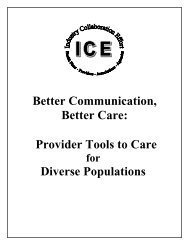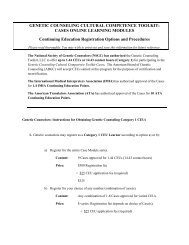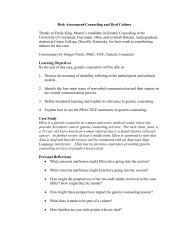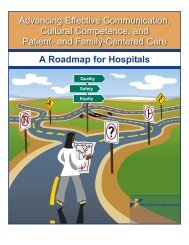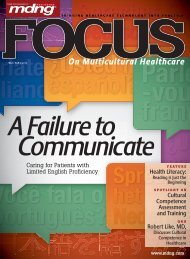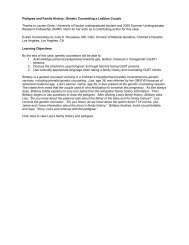making the business case for culturally and linguistically appropriate ...
making the business case for culturally and linguistically appropriate ...
making the business case for culturally and linguistically appropriate ...
Create successful ePaper yourself
Turn your PDF publications into a flip-book with our unique Google optimized e-Paper software.
APPENDIX JTeleSaludMolina Healthcare Inc.CLAS St<strong>and</strong>ards Met: 4,5 <strong>and</strong> 7See page 12 <strong>for</strong> list of CLAS St<strong>and</strong>ardsISSUE. In 2002, a review of utilization statistics from Molina Healthcare’s outsourced nurseadvice line was significantly underutilized by Spanish-speaking members (Latinos). Thereport showed that although 45% of Molina’s membership is Latino (primarily of Mexicanorigin), with a declared Spanish language preference, requests <strong>for</strong> a Spanish interpreterconstituted less than two percent of calls. Molina concluded that this low utilizationsuggested a barrier to members in accessing nurse advice services. Previous internal researchsupported <strong>the</strong> finding that while English speaking populations would use automated phoneservices, Spanish speaking populations were more likely to hang up when reachingautomated services. The practice of waiting in line <strong>for</strong> service was not congruent with <strong>the</strong>Latino culture, which could adversely affect <strong>the</strong>ir access to healthcare.DISCUSSION. Molina Healthcare, Inc., headquartered in Long Beach, Cali<strong>for</strong>nia, is amulti-state managed care organization that arranges <strong>for</strong> <strong>the</strong> delivery of healthcare services tolow-income families <strong>and</strong> individuals eligible <strong>for</strong> Medicaid <strong>and</strong> o<strong>the</strong>r government-sponsoredprograms. In an ef<strong>for</strong>t to decrease <strong>the</strong> number of Spanish speaking patients hanging up whenreaching automated services <strong>the</strong> TeleSalud demonstration project was <strong>for</strong>med in 2004 as aseparate department within Molina Healthcare of Cali<strong>for</strong>nia to offer direct accessibility <strong>for</strong>medical interpreting services to address <strong>the</strong> health <strong>and</strong> language needs of <strong>the</strong> underservedLimited English Proficient Latino population living in <strong>the</strong> Inl<strong>and</strong> Empire of Sou<strong>the</strong>rnCali<strong>for</strong>nia.TeleSalud was started as a program component under <strong>the</strong> Hablamos Juntos demonstrationproject grant, funded by <strong>the</strong> Robert Wood Johnson Foundation to exp<strong>and</strong> <strong>the</strong> language accessservices capacity in <strong>the</strong> Inl<strong>and</strong> Empire region of Sou<strong>the</strong>rn Cali<strong>for</strong>nia. The TeleSaluddemonstration project began as a 24-hour contact center to enable direct access to a SpanishspeakingRegistered Nurse to help address a Spanish-speaking members’ health <strong>and</strong>interpreter needs at all times. TeleSalud initially offered three primary services exclusivelyin Spanish: nurse advice, medical interpretation, <strong>and</strong> member services. The TeleSaludSpanish nurse advice program was implemented in several phases. The launch date wasearlier than originally planned due to operational considerations, <strong>and</strong> so was initially staffedby nurse practitioners <strong>and</strong> physicians. No advertising was done during this phase, as part ofwhat was being monitored was member awareness of in<strong>for</strong>mation printed on <strong>the</strong>ir cards.Phase 2 began in October 2004, with launch of computerized protocols <strong>and</strong> a fully trainednursing staff. Because <strong>the</strong> program was so well received, in November 2004, <strong>the</strong> decisionwas made to open <strong>the</strong> TeleSalud project beyond <strong>the</strong> Inl<strong>and</strong> Empire area, to all Cali<strong>for</strong>niamembers on January 1, 2005; <strong>the</strong> original pilot group only included 80,000 members in <strong>the</strong>Sou<strong>the</strong>rn Cali<strong>for</strong>nia counties of Riverside <strong>and</strong> San Bernardino.BENEFITS/RESULTS.There are many indirect cost benefits that have been identified with TeleSalud. The project’sgains are multi-faceted, <strong>and</strong> <strong>the</strong> bilingual capacity of <strong>the</strong> TeleSalud staff has been valuable to52



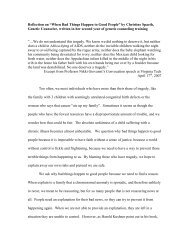
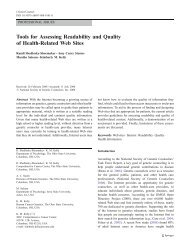

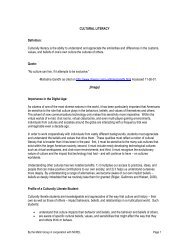
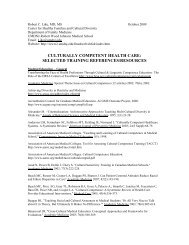

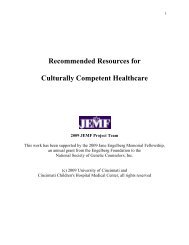
![Breaking Bad News PPT[1] - Genetic Counseling Cultural ...](https://img.yumpu.com/35003134/1/190x146/breaking-bad-news-ppt1-genetic-counseling-cultural-.jpg?quality=85)
